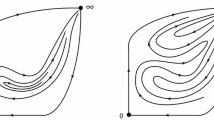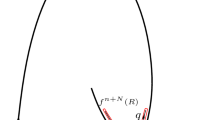Abstract
In this article we study some statistical aspects of surface diffeomorphisms. We first show that for a \(C^1\) generic diffeomorphism, a Dirac invariant measure whose statistical basin of attraction is dense in some open set and has positive Lebesgue measure, must be supported in the orbit of a sink. We then construct an example of a \(C^1\)-diffeomorphism having a Dirac invariant measure, supported on a saddle-type hyperbolic fixed point, whose statistical basin of attraction is a nowhere dense set with positive Lebesgue measure. Our technique can be applied also to construct a \(C^1\) diffeomorphism whose set of points with historic behaviour has positive measure and is nowhere dense.


























Similar content being viewed by others
Notes
The same statement holds for periodic points, with a similar proof.
The adjective exterior refers to the fact the boxes \(S_n^e\) will be contained in the exterior connected components of the complement of the figure-eight attractor we shall produce in this section.
The dependence of \({\mathcal {S}}\) and \({\tilde{{\mathcal {S}}}}\) on \(n_0\) is not explicit in our notation because we shall fix once and for all the integer \(n_0\).
See [30] for instance.
Recall that this means that, inside V, the map f is topologically conjugate to its linear part Df at O.
We have used here the well known fact that every periodic orbit of a planar vector field bounds a disk containing a zero of the vector field inside. This can be proved combining Poincaré-Bendixon’s theorem with Zorn’s lemma.
Just as an example, fix some \(R>1\) and let \(p=(0,0) \in U=B(0,1) \subset W_0=B(0,R)\). Consider first the real function \(g:W_0{\setminus }{\overline{U}}\rightarrow (0,1)\) given by
$$\begin{aligned} g(x,y)=\frac{1}{R-1}\,\frac{1}{\sqrt{x^2+y^2}}\,\big (R-\sqrt{x^2+y^2}\big )\,, \end{aligned}$$and then let \(\psi _{U}:W_0{\setminus }{\overline{U}} \rightarrow U{\setminus }\{p\}\) be given by \(\psi _{U}(x,y)=g(x,y)\,\big (x,y\big )\).
A point \(x\in M\) is said to have historic behaviour if the sequence \(\frac{1}{n}\sum \limits _{j=0}^{n-1}\delta _{f^{j}(x)}\) does not converge in the weak-* topology.
It may be that the diffeomorphism \(h_1\) is useless to get the desired result; however it simplifies significantly the proofs.
This phenomenon has already been shown in Lemma 4.5.
For boxes \(s_v(S_n)\) of the exterior \({\mathcal {L}}^e\) of the attractor, one has to change the powers of 16 by powers of 4, as the return map of \(f_1\) to the union of such boxes is, after renormalization, a rotation of angle \(\pi \).
References
Avila, A., Lyubich, M., de Melo, W.: Regular or stochastic dynamics in real analytic families of unimodal maps. Inventiones mathematicae 154(3), 451–550 (2003)
Benedicks, M., Carleson, L.: On iterations of \(1-ax^2\) on \((-1, 1)\). Ann. Math. 122, 1–25 (1985)
Bochi, J., Bonatti, C.: Perturbation of the Lyapunov spectra of periodic orbits. Proc. Lond. Math. Soc. 105(1), 1–48 (2012)
Bonatti, C., Díaz, L.J., Pujals, E.R.: A \(C^1\)-generic dichotomy for diffeomorphisms: weak forms of hyperbolicity or infinitely many sinks or sources. Ann. Math. (2) 158(2), 355–418 (2003)
Bonatti, C., Crovisier, S.: Récurrence et généricité. Inventiones mathematicae 158(1), 33–104 (2004)
Bowen, R.: Periodic points and measures for axiom a diffeomorphisms. Trans. Am. Math. Soc. 154, 377–397 (1971)
Bowen, R.: Invariant measures for Markov maps of the interval. Commun. Math. Phys. 69(1), 1–17 (1979)
Bruin, H., Rivera-Letelier, J., Shen, W., van Strien, S.: Large derivatives, backward contraction and invariant densities for interval maps. Inventiones mathematicae 172(3), 509–533 (2008)
Catsigeras, E., Cerminara, M., Enrich, H.: The Pesin entropy formula for \(C^1\) diffeomorphisms with dominated splitting. Ergod. Theory Dyn. Syst. 35(3), 737–761 (2015)
Collet, P., Eckmann, J.-P.: Positive Lyapunov exponents and absolute continuity for maps of the interval. Ergod. Theory Dyn. Syst. 3(1), 13–46 (1983)
Colli, E., Vargas, E.: Non-trivial wandering domains and homoclinic bifurcations. Ergod. Theory Dyn. Syst. 21(6), 1657–1681 (2001)
Conley, C.C.: Isolated Invariant Sets and the Morse Index, vol. 38. American Mathematical Society, Providence (1978)
Crovisier, S., Guarino, P., Palmisano, L.: Ergodic properties of bimodal circle maps. Ergod. Theory Dyn. Syst. 39(6), 1462–1500 (2019)
Fayad, B., Katok, A., Windsor, A.: Mixed spectrum reparameterizations of linear flows on \({\mathbb{T}}^2\). Mosc. Math. J. 1(4), 521–537 (2001)
Gaunersdorfer, A.: Time averages for heteroclinic attractors. SIAM J. Appl. Math. 52(5), 1476–1489 (1992)
Golenishcheva-Kutuzova, T., Kleptsyn, V.: Investigation of the convergence of the Krylov–Bogolyubov procedure in Bowen’s example. Mat. Zametki 82(5), 678–689 (2007)
Gourmelon, N.: A Franks’ lemma that preserves invariant manifolds. Ergod. Theory Dyn. Syst. 36(4), 1167–1203 (2016)
Hirsch, M.W.: Differential topology. Graduate Texts in Mathematics, vol. 33. Springer-Verlag, New York-Heidelberg (1976)
Hofbauer, F., Keller, G.: Quadratic maps without asymptotic measure. Commun. Math. Phys. 127(2), 319–337 (1990)
Hu, H.Y., Young, L.-S.: Nonexistence of SBR measures for some diffeomorphisms that are “almost Anosov”. Ergod. Theory Dyn. Syst. 15(1), 67–76 (1995)
Jakobson, M.: Absolutely continuous invariant measures for one-parameter families of one-dimensional maps. Commun. Math. Phys. 81(1), 39–88 (1981)
Kiriki, S., Soma, T.: Takens’ last problem and existence of non-trivial wandering domains. Adv. Math. 306, 524–588 (2017)
Kleptsyn, V.: An example of non-coincidence of minimal and statistical attractors. Ergod. Theory Dyn. Syst. 26(3), 759–768 (2006)
Kwapisz, J., Mathison, M.: Diophantine and minimal but not uniquely ergodic (almost). Nonlinearity 25(7), 2027–2037 (2012)
Ledrappier, F.: Some properties of absolutely continuous invariant measures on an interval. Ergod. Theory Dyn. Syst. 1(1), 77–93 (1981)
Lyubich, M.: Almost every real quadratic map is either regular or stochastic. Ann. Math. 156, 1–78 (2002)
Mañé, R.: Ergodic Theory and Differentiable Dynamics, vol. 8. Springer, Berlin (2012)
Morales, C.A., Pacifico, M.J.: Lyapunov stability of \(\omega \)-limit sets. Discrete Contin. Dyn. Syst. A 8(3), 671–674 (2002)
Newhouse, S.E.: Lectures on dynamical systems. In: Dynamical systems (C.I.M.E. Summer School, Bressanone, 1978), pp. 1–114, Progr. Math., 8, Birkhäuser, Boston, Mass (1980)
Palis, J., de Melo, W.: Geometric theory of dynamical systems. Springer, New York. An Introduction. Translated from the Portuguese by A.K. Manning (1982)
Palis, J.: A global view of dynamics and a conjecture on the denseness of finitude of attractors. Astérisque 261(xiiixiv), 335–347 (2000)
Potrie, R.: Generic bi-Lyapunov stable homoclinic classes. Nonlinearity 23(7), 1631 (2010)
Saghin, R., Sun, W., Vargas, E.: On Dirac physical measures for transitive flows. Commun. Math. Phys. 298(3), 741–756 (2010)
Saghin, R., Vargas, E.: Invariant measures for Cherry flows. Commun. Math. Phys. 317(1), 55–67 (2013)
Santiago, B.: Dirac physical measures for generic diffeomorphisms. Dyn. Syst. 33(2), 185–194 (2018)
Sigmund, K.: On dynamical systems with the specification property. Trans. Am. Math. Soc. 190, 285–299 (1974)
Takens, F.: Heteroclinic attractors: time averages and moduli of topological conjugacy. Bol. Soc. Bra. Mat. (N.S.) 25(1), 107–120 (1994)
Wang, Q., Young, L.-S.: Nonuniformly expanding 1d maps. Commun. Math. Phys. 264, 255–282 (2006)
Whitney, H.: Analytic extensions of differentiable functions defined in closed sets. Trans. Am. Math. Soc. 36(1), 63–89 (1934)
Young, L.-S.: Recurrence times and rates of mixing. Israel J. Math. 110, 153–188 (1999)
Young, L.-S.: What are SRB measures, and which dynamical systems have them? J. Stat. Phys. 108(5), 733–754 (2002)
Author information
Authors and Affiliations
Corresponding author
Additional information
Publisher's Note
Springer Nature remains neutral with regard to jurisdictional claims in published maps and institutional affiliations.
We warmly thank Sylvain Crovisier for his ideas concerning Theorem A, Christian Bonatti for the attention he paid to this work and Davi Obata for his reading of a first draft. We express our very great appreciation to the referee for very keen remarks leading to a considerable improvement of our exposition. P.G. and P.A.G were partially supported by Coordenação de Aperfeiçoamento de Pessoal de Nível Superior—Brasil (CAPES) Grant 23038.009189/2013-05. P.A.G. was partially funded by the France-Brazil network (RFBM). P.A.G and B.S. were partially supported by a PEPS (CNRS) Grant. B.S. was partially financed by the Coordenação de Aperfeiçoamento de Pessoal de Nível Superior - Brasil (CAPES) - Finance Code 001 and also acknowledges the support of Fondation Louis D—Institut de France (Project coordinated by M. Viana).
Rights and permissions
About this article
Cite this article
Guarino, P., Guihéneuf, PA. & Santiago, B. Dirac Physical Measures on Saddle-Type Fixed Points. J Dyn Diff Equat 34, 983–1048 (2022). https://doi.org/10.1007/s10884-020-09911-x
Received:
Revised:
Accepted:
Published:
Issue Date:
DOI: https://doi.org/10.1007/s10884-020-09911-x




